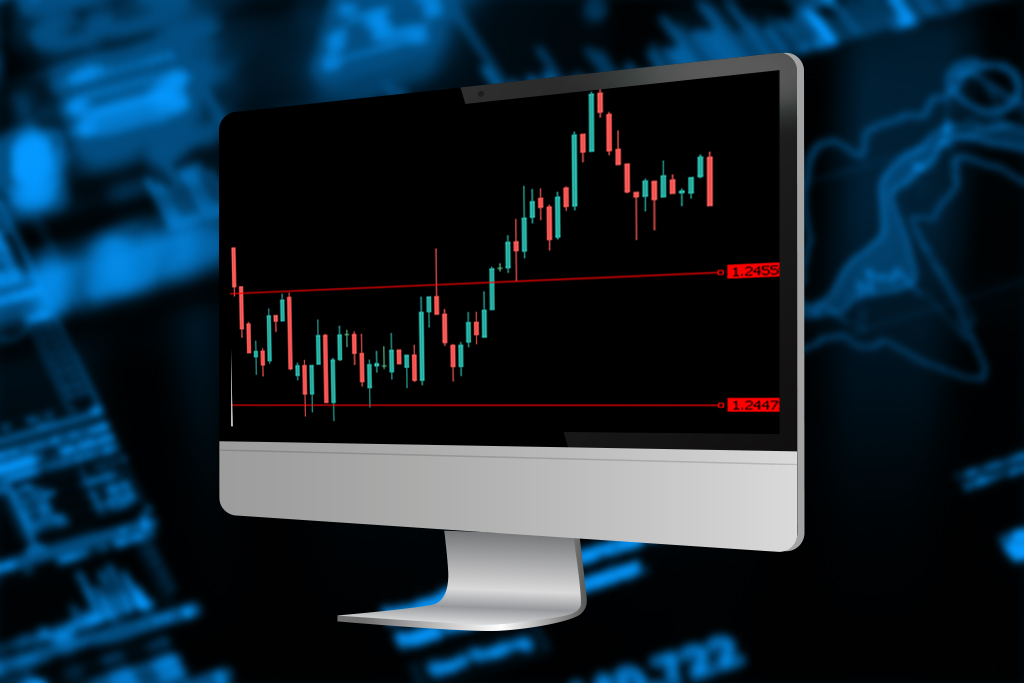The Most Volatile CFD Instruments of 2022

The world of finance and investment is ever-evolving, marked by fluctuations and volatility that can be both exciting and challenging. In 2022, numerous financial instruments experienced significant price swings, capturing the attention of traders and investors alike. In this article, we delve into the realm of Contracts for Difference (CFDs) and explore the most volatile CFD instruments of 2022. By examining their performances, analyzing market trends, and studying historical data, we can gain insights into the factors that influenced their volatility.
Bitcoin (BTC/USD)

Bitcoin, the world’s leading cryptocurrency, dominated the headlines in 2022 with its wild price swings. The digital asset experienced several remarkable price movements throughout the year, driven by factors such as regulatory developments, institutional adoption, macroeconomic events, and investor sentiment.
In the first quarter of 2022, Bitcoin witnessed an astounding decline from around $50,000 to over 60% low price of nearly $17,000 by July. However, it soon experienced a sharp correction, raising its price back to around $25,000 with monthly ranges of roughly 2500 USD. This volatility continued throughout the year, with Bitcoin experiencing multiple significant price swings which are also visible this year.
Previously in 2021, Bitcoin went through a remarkable surge, reaching over $64,000, only to experience a subsequent drop to around $30,000 in June. These extreme price fluctuations provided traders with numerous opportunities to capitalize on short-term price movements and potentially capture substantial profits.
The war in Ukraine also had indirect effects on Bitcoin through its impact on global financial markets and investor sentiment. Geopolitical uncertainties can lead to increased market volatility and risk aversion, affecting traditional financial assets. As a result, investors may turn to Bitcoin and other cryptocurrencies, perceiving them as independent of centralized authorities and potentially immune to geopolitical events.
Moreover, geopolitical tensions and conflicts can influence regulatory attitudes toward cryptocurrencies. Governments may introduce new policies or restrictions that affect the cryptocurrency market, including Bitcoin. Traders and investors closely monitored regulatory developments during the war in Ukraine, as they could have implications for Bitcoin’s adoption, liquidity, and overall market sentiment.
Investors sought alternatives to traditional financial assets during times of heightened geopolitical risk, and Bitcoin, with its decentralized and borderless nature, was perceived as a potential hedge against economic instability and currency devaluation. Moreover, indirect effects of the war, such as increased market volatility and regulatory considerations, impacted Bitcoin’s volatility.
When analyzing Bitcoin’s volatility, it is crucial to consider a wide range of factors that influence the cryptocurrency market. Geopolitical events can act as catalysts, but they interact with other elements in a complex ecosystem. Traders and investors should remain vigilant, stay informed about geopolitical developments, and assess the overall market dynamics when engaging with Bitcoin or any other cryptocurrencies.
Oil (WTI Crude Oil)

WTI crude oil, a key benchmark in the oil market, remained subject to volatility throughout 2022. The price of oil is influenced by various factors, including geopolitical tensions, supply and demand dynamics, macroeconomic indicators, and OPEC decisions.
Significant events that impacted oil prices in 2022 were the escalating tensions in the Middle East, particularly concerning Iran and its oil exports, and the war in Ukraine. The geopolitical uncertainties and the potential for disruptions in oil supply added volatility to the oil market. Any indications of military conflicts, trade disputes, or political instability in oil-producing regions heightened concerns about supply availability, leading to price fluctuations.
The war in Ukraine had a significant impact on the volatility of WTI crude oil prices in 2022. Geopolitical tensions and conflicts in oil-producing regions can disrupt supply chains, raise concerns about energy security, and influence oil prices. The conflict’s proximity to important oil infrastructure and the potential for interference with oil transportation routes heightened market uncertainties and increased oil price volatility.
Traders and investors closely monitored developments in Ukraine, including ceasefire agreements, military actions, and diplomatic negotiations, as these factors influenced the overall sentiment in the oil market. Any signs of escalation or de-escalation in the conflict had the potential to trigger price movements in WTI crude oil.
Furthermore, the global economic recovery from the COVID-19 pandemic played a crucial role in oil price volatility. As countries gradually reopened their economies and resumed economic activities, the demand for oil experienced fluctuations. Positive economic indicators and increased industrial production often resulted in higher demand for oil, driving prices upwards. Conversely, any signs of economic slowdown or reduced energy consumption exerted downward pressure on oil prices. The decisions and actions of OPEC, the organization of oil-producing countries, also significantly influenced oil price volatility. OPEC’s production quotas and adjustments to supply levels had a direct impact on oil prices. Any unexpected changes in production targets or disagreements among member countries could trigger price swings in the oil market.
Moreover, macroeconomic indicators, such as global GDP growth rates, inflation levels, and interest rate policies, played a role in determining the overall demand for oil. Economic data releases and central bank announcements could cause oil price movements as market participants assessed the implications for energy consumption and future demand.
Tesla (TSLA)

Tesla, the electric vehicle and clean energy company led by Elon Musk, emerged as another highly volatile CFD instrument in 2022. Tesla’s stock price was influenced by a multitude of factors, including production numbers, delivery figures, regulatory developments, investors’ expectations and market sentiment toward electric vehicles.
Production and Delivery Numbers:
Tesla’s stock price was closely tied to its production and delivery numbers. Any announcements or reports regarding the company’s ability to meet production targets and deliver vehicles on time had a significant impact on investor sentiment. Positive news of exceeding production expectations often resulted in price increases, while any delays or production challenges led to sharp declines.
Regulatory Developments:
Regulatory developments and changes in government policies related to electric vehicles influenced Tesla’s stock volatility. Updates on emission standards, government incentives, and regulations regarding autonomous driving technologies had a direct impact on the market sentiment towards Tesla. Positive regulatory developments often bolstered investor confidence, while any negative regulatory news or concerns created uncertainty and potential downside risk.
Market Sentiment Towards Electric Vehicles:
Tesla’s stock price was also influenced by broader market sentiment towards electric vehicles. As the leading player in the electric vehicle market, Tesla’s performance was closely linked to investor expectations for the industry as a whole. Positive developments, such as increased adoption of electric vehicles, expansion of charging infrastructure, and growing demand, generally had a positive impact on Tesla’s stock. Conversely, any negative news or concerns about competition, battery technology, or the pace of market adoption mightlead to downward pressure on the stock price.
Investor Expectations and Speculation:
Tesla’s stock was subject to significant speculation and investor expectations. The company’s visionary CEO, Elon Musk, often made headlines with his ambitious plans, innovative ideas, and market-moving tweets. Investor sentiment and expectations were influenced by Musk’s statements and actions, which resulted in dramatic price movements. Speculative trading activity and short-term market dynamics also contributed to the volatility of Tesla’s stock.
Positive news, such as better-than-expected production figures, new product announcements, or favorable regulatory developments, usually trigger rapid price increases. Conversely, negative news, production challenges, missed targets, or concerns about competition and market conditions can lead to sharp declines in the stock price.
One notable event for Tesla in 2022 was its entry into new markets and the expansion of its production capacity. The company’s Gigafactories in Berlin and Texas gained significant attention, with investors closely monitoring progress and updates. Positive news regarding production milestones and delivery numbers often led to substantial price increases, while any setbacks or regulatory challenges caused sharp downward corrections.
For instance, in March 2022, Tesla’s stock experienced a significant rally, driven by better-than-expected production figures and strong demand. The stock surged from around $800 to over $1100 within a short period. However, in the second part of the year, concerns over supply chain disruptions and regulatory hurdles resulted in a sharp decline, with the stock price falling rapidly.
Gold (XAU/USD)

Gold, known as a traditional safe-haven asset, continued to exhibit significant volatility in 2022. The price of gold is influenced by a multitude of factors, including global economic conditions, inflationary pressures, interest rates, and geopolitical tensions.
In the first half of 2022, gold experienced a notable rally, with its price surpassing the $2,000 per ounce mark. This rally was primarily driven by concerns about inflationary pressures and geopolitical tensions. Investors sought refuge in gold as a hedge against potential currency devaluation and economic downturns. In addition to the factors mentioned earlier, the war in Ukraine also had a notable impact on the volatility of gold prices in 2022. Geopolitical tensions and armed conflicts can significantly influence investor sentiment and increase the demand for safe-haven assets like gold.
The war in Ukraine, which escalated in 2022, created uncertainties and geopolitical risks, prompting investors to seek refuge in gold as a safe-haven asset. Concerns over potential spillover effects, regional stability, and the impact on global political and economic relations heightened the demand for gold.
Global inflationary fears, particularly due to massive fiscal stimulus measures and accommodative monetary policies adopted in response to the COVID-19 pandemic, contributed to the surge in gold prices. Additionally, geopolitical tensions, such as trade disputes and political uncertainties, further fueled the demand for gold as a safe-haven asset.
However, as the year progressed, central banks began signaling a shift towards tighter monetary policies to curb inflationary pressures. This change in stance, along with signs of economic stability and recovery, led to a decline in the demand for gold.
In the second half of 2022, gold experienced a significant correction, with its price retreating from the highs reached earlier in the year. The reduced demand for safe-haven assets, coupled with a strengthening U.S. dollar and improving economic indicators, contributed to the downward pressure on gold prices.
Furthermore, as central banks started raising interest rates and scaling back monetary stimulus, investors’ focus shifted towards other asset classes that offered higher yields and potential returns. This shift in investor sentiment away from gold added to the downward pressure on its price.
Gold’s volatility in 2022 was largely influenced by global economic conditions, inflationary pressures, interest rates, and geopolitical tensions. The metal witnessed a significant rally in the first half of the year due to concerns over inflation and geopolitical uncertainties. However, as central banks signaled tighter monetary policies and economic stability improved, the demand for gold diminished, leading to a subsequent decline in its price.

In 2022, Bitcoin, Tesla, Oil (WTI crude oil), and Gold emerged as some of the most volatile instruments. Bitcoin’s volatility was fueled by regulatory developments, institutional adoption, macroeconomic events, and investor sentiment. Tesla’s stock price experienced significant swings based on production numbers, delivery figures, regulatory developments, and market sentiment toward electric vehicles. WTI Oil and Gold have reacted to inflation, supply and demand, geopolitical conditions, and the USD volatility.
* The information provided here has been prepared by Eightcap’s team of analysts. All expressions of opinion are subject to change without notice. Any opinions made may be personal to the author and do not reflect the opinions of Eightcap.
In addition to the disclaimer on our website, the material on this page does not contain a record of our trading prices, or represent an offer or solicitation for a transaction in any financial instrument. Eightcap accepts no responsibility for any use that may be made of these comments and for any consequences that result. No representation or warranty is given as to the accuracy or completeness of this information. Consequently, any person acting on it does so entirely at their own risk. Any research provided does not have regard to the specific investment objectives, financial situation and needs of any specific person who may receive it. It has not been prepared in accordance with legal requirements designed to promote the independence of investment research and as such is considered to be a marketing communication.
Please note that past performance is not a guarantee or prediction of future performance. This communication must not be reproduced or further distributed without prior permission.


